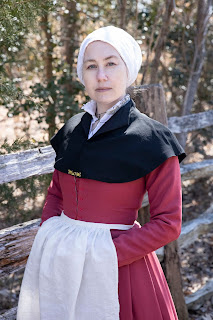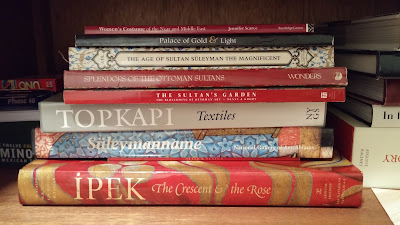16th Century Accessories for Northern Europe and the Holy Roman Empire
The accessories for Northern Europe and the Holy Roman Empire are similar to the English ones but have their own regional differences. While both have caps, aprons, and partlets, the terms used are not the same. The main areas I am focusing on are what we now call Germany, Switzerland, and the Netherlands. I am not going to cover the distinctive dress of the "Trossfrau", the women who followed the Landsknecht soldiers, as their style is very unique to their station.
Splendor Solis, 1532-1535. Kupferstichkabinett Berlin.
The term that I understand to be the German equivalent to kirtle is underrock. The word rock means dress or gown, so underrock would mean an under dress. In Northern European paintings, the underrock is usually softer in shape than an English kirtle, with a rounder bust shape. Like kirtles, they could close in front, back, or sides. Front closing with hidden lacing rings or hooks and eyes seems to be the most common, but I was able to find several images that showed front lacing.
The linen undergarment is still essential in Northern Europe. It was called a hemd in the Germanic regions. They could be low necked or have a high collar, often using intricate smocking to gather large amounts of fabric around the neck and wrists. I opted for a simple style with a low neck, made with rectangular construction, and sleeves tapered to the wrist.
I am wearing a linen partlet in addition to the hemd. At this point I do not know the German word for partlet but I would love to hear from you if you do! My partlet is made from very fine lightweight linen and machine embroidered to mimic blackwork embroidery from the 16th century. It is patterned like a shirt, with wide rectangular body panels gathered to a collar. The partlet ties below the bust.
| | ||
Lucas Cranach the Elder, Birth of John the Baptist, 1518.
| Albrecht Altdorfer, Seated Woman Bathing Her Feet, early 16th c. The Met. |
The small cape worn around the shoulder is called a gollar. Mine is made from black worsted wool and lined with black linen. I modified the Tudor Tailor partlet pattern for mine, but if you search "gollar pattern" on Pinterest you will find a few great versions. Wool was probably the most common fabric for a gollar for the working and middle classes, but they can be made from fine silks and velvets, and also lined in fur.
Portrait of the wife of Georg Pencz; attributed to Georg Pencz, 1530-1570, British Museum.
Like the English styles, aprons in the Germanic region would be made from linen or wool. I chose a medium weight white linen, hand gathered to a matching waistband, like the one seen below.
Jörg Breu the Elder,1531-1550, "Augsburg Labours of the Months: Winter (October, November, December)", Deutsches Historisches Museum, Berlin.
The Peasants' Feast, circa 1537. By Sebald Beham, the British Museum.
I highly recommend the book "Drei Schnittbucher" by Katherine Barich and Marion McNealy:
https://www.amazon.com/Drei-Schnittbucher-Austrian-Master-Century/dp/0692472452/ref=cm_cr_arp_d_product_top?ie=UTF8
Websites I recommend for further reading and more in depth research:
http://germanrenaissance.net/
https://amiesparrow.wordpress.com/
https://whiljascorner.wordpress.com/
An extant under dress: Kostym.cz



















A cooking Aprons safeguards the upper body from splashes, heat, and flames, made from durable cotton twill.
ReplyDeleteMarriage counseling provides valuable tools and guidance to create and maintain healthier, more fulfilling partnerships. Cincinnati Marriage Counselors
ReplyDeletetold me Thomas will come back between 48 hrs if am ready to pay for the items he will use to Cast spell on him so i agree to pay for the items then give him necessary information he required, after that Dr told me to wait for 48 hours that Thomas will come back to me with rose flower and apologize. while waiting for Thomas to come back between 48 hours because i believe what Dr Guba, said so i was so excited to see Thomas,the next day evening someone was knocking my Door then i was in shower so when i finish i went straight to the door and see Thomas with flowers and telling me he was so sorry that i should forgive him. now things change better in my life because i have Thomas back in my life, thanks to Dr Guba, for fulfilled his promise to me. contact him via Email via Gubasolutionhome@gmail.com or call him Whatsapp +2347077581439)
ReplyDelete